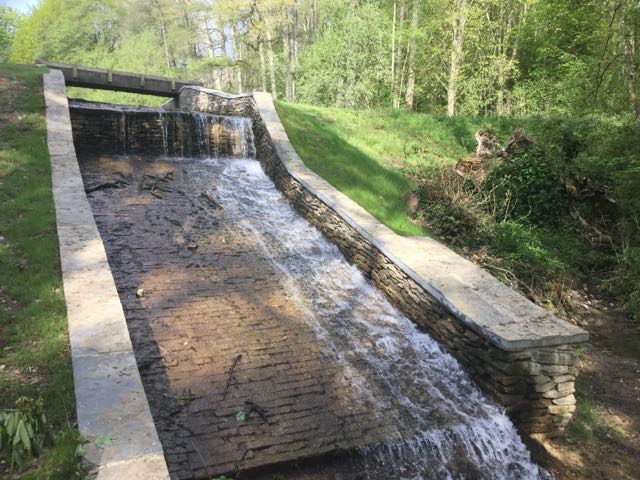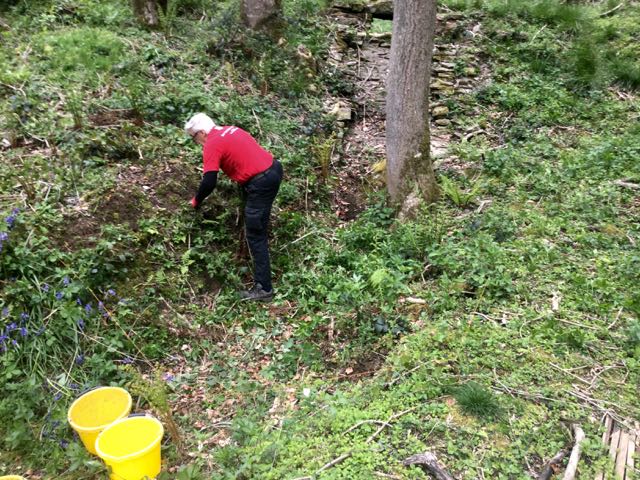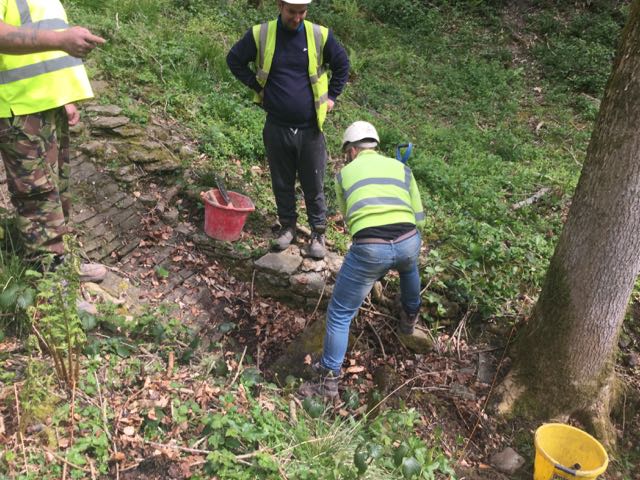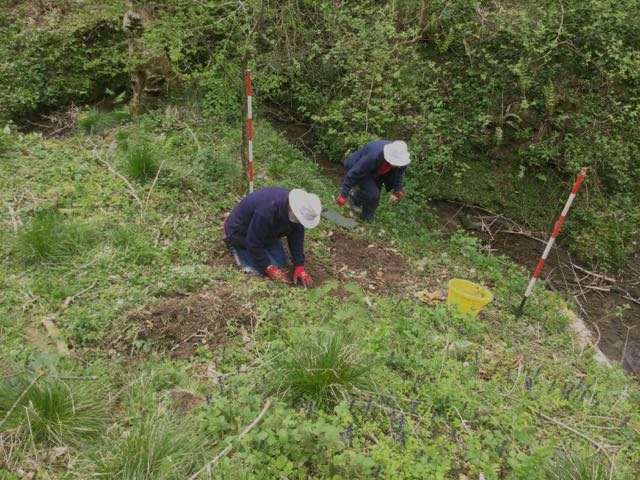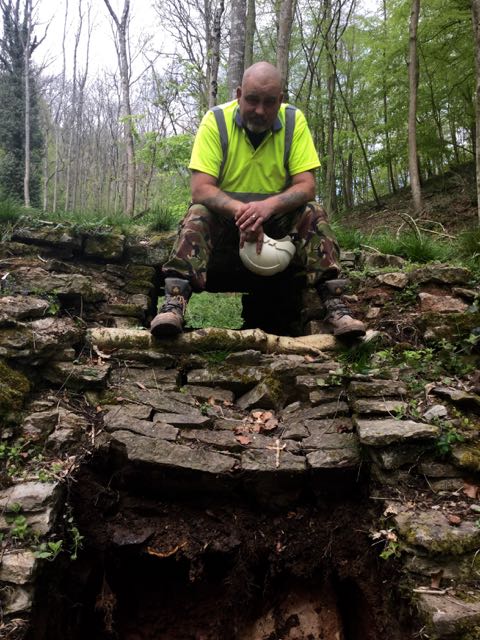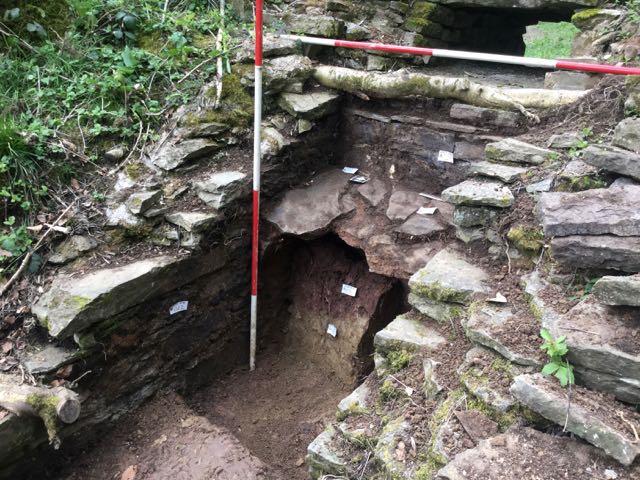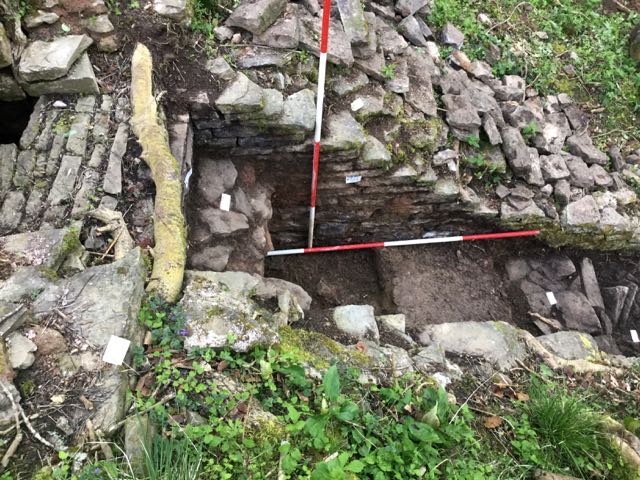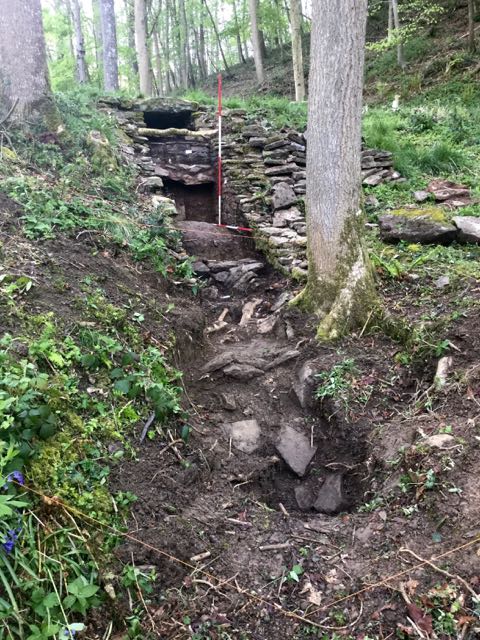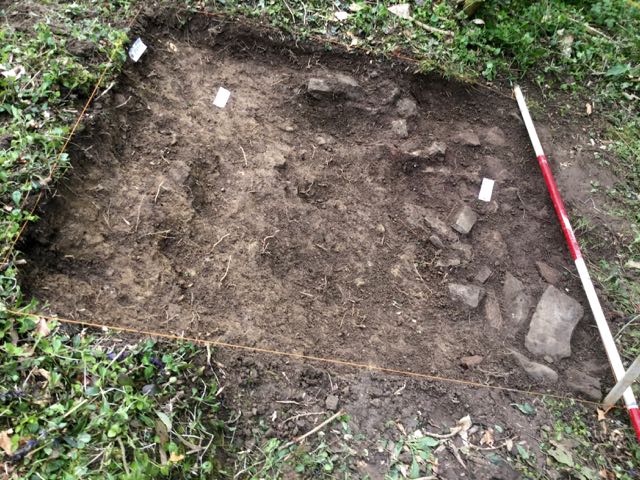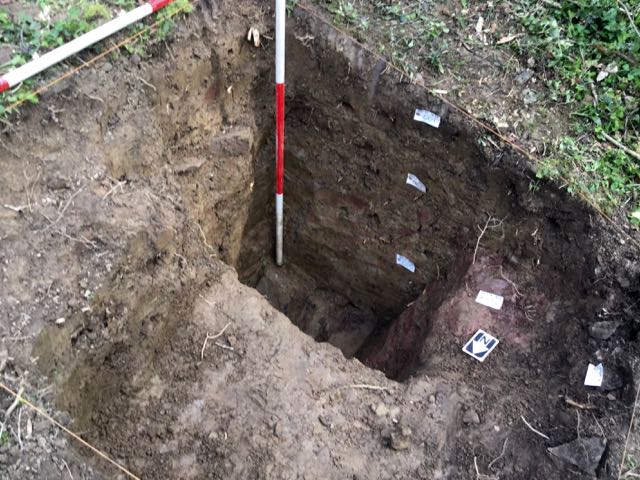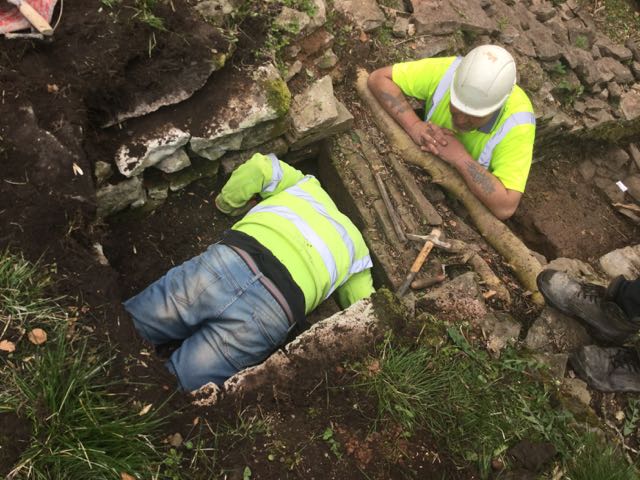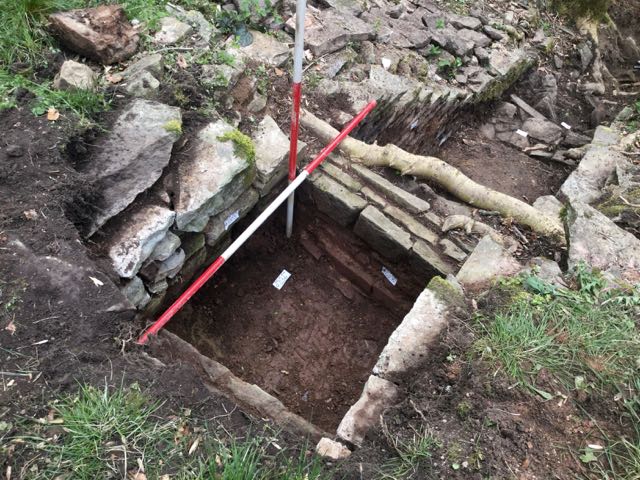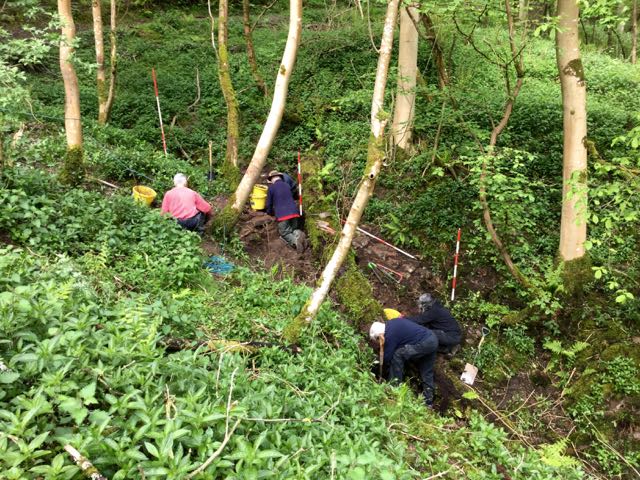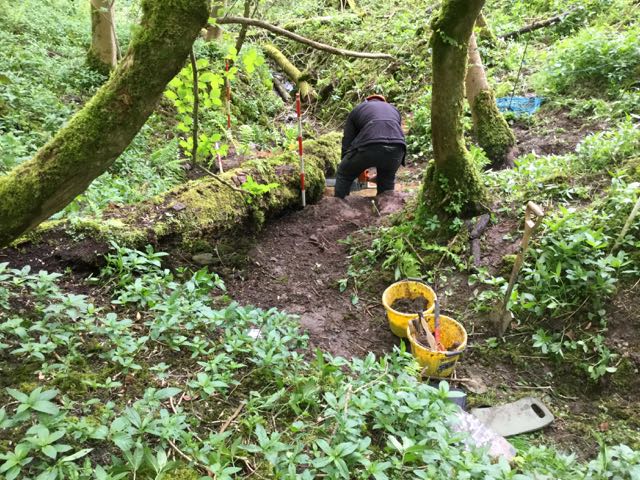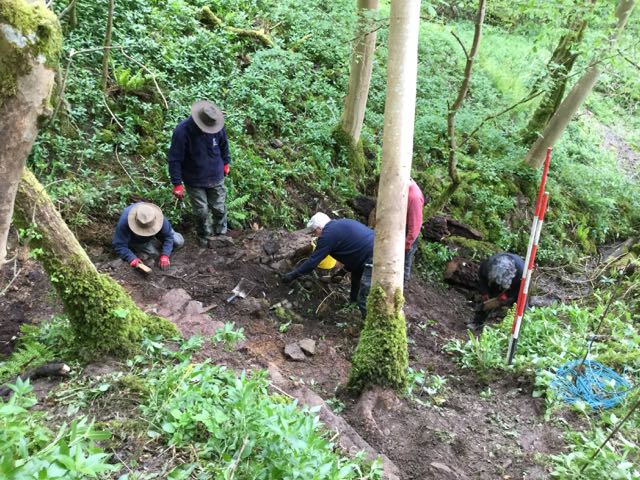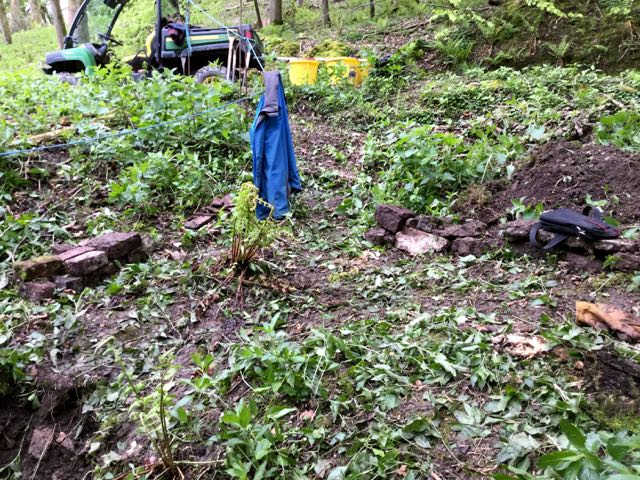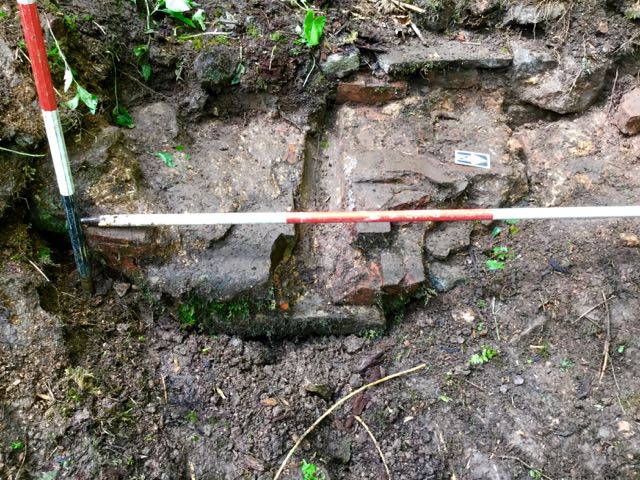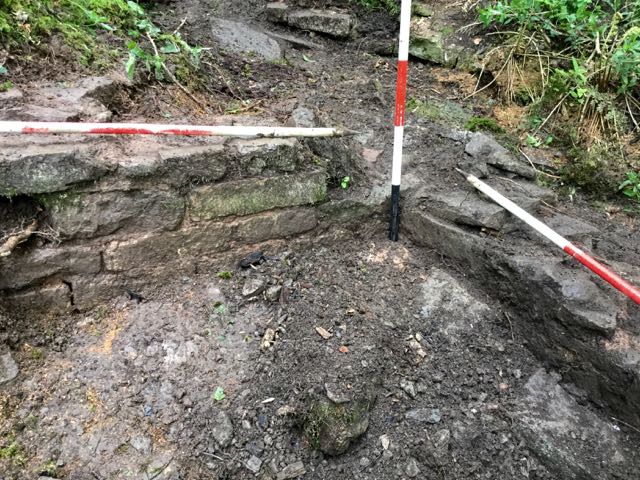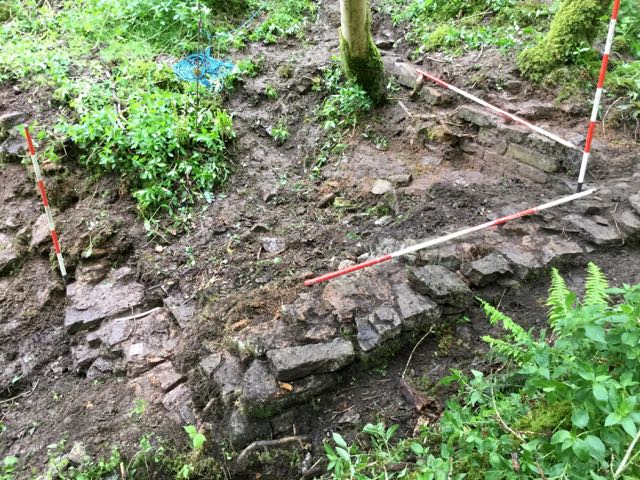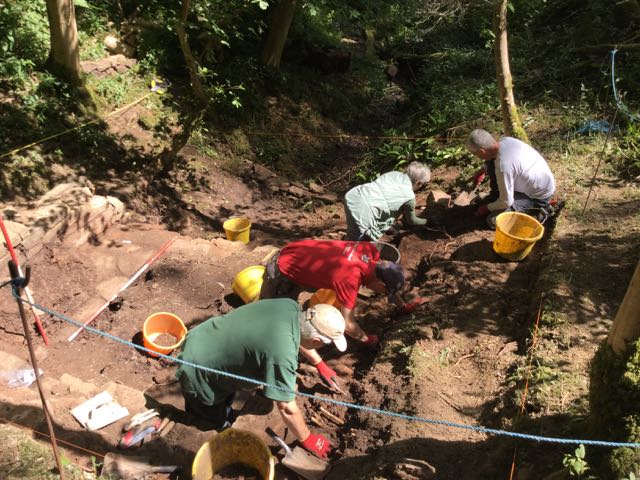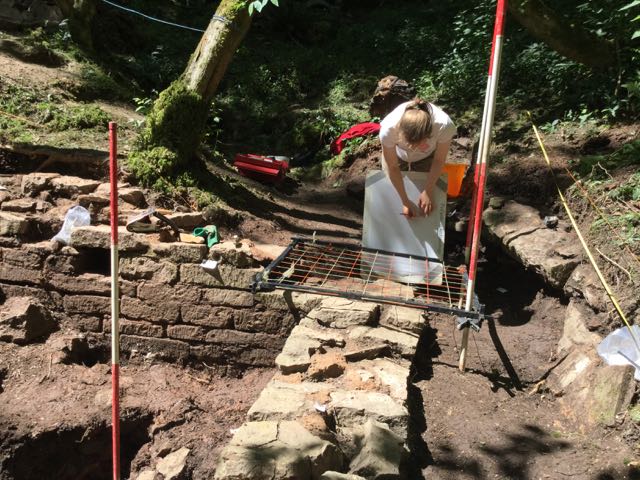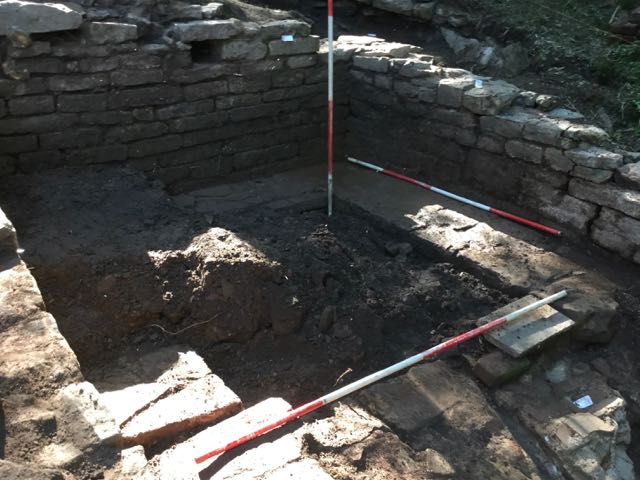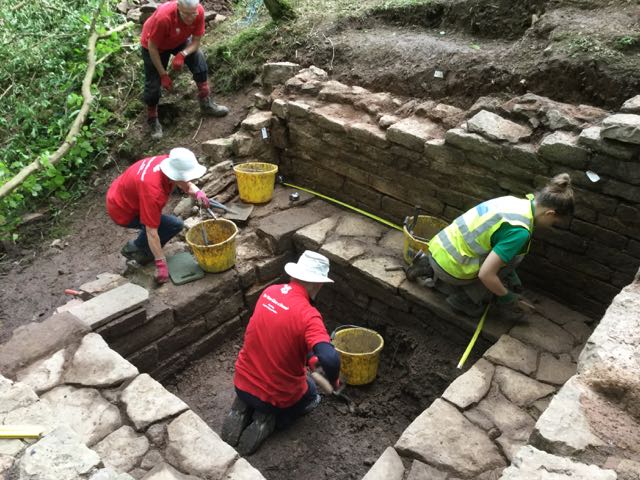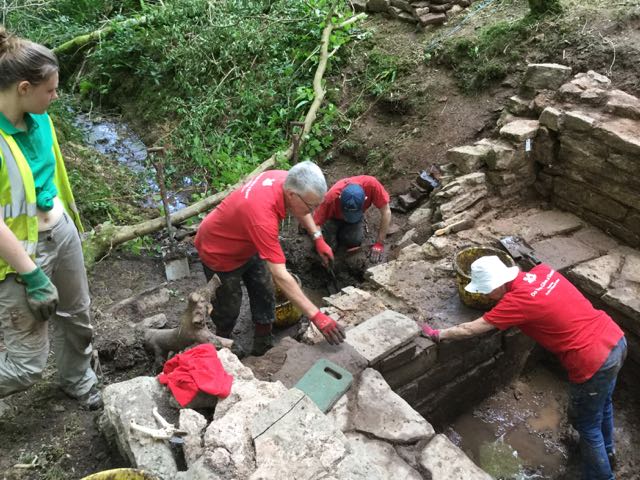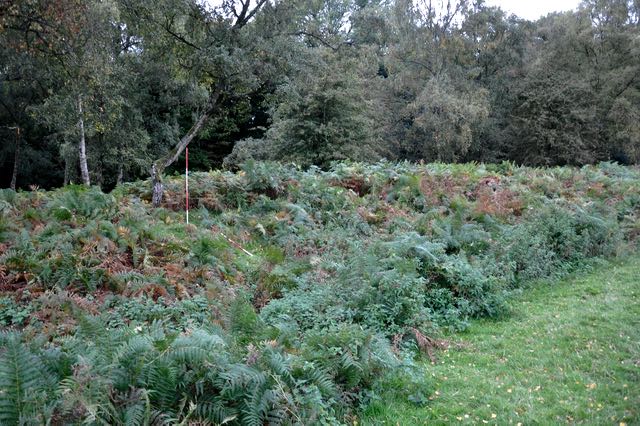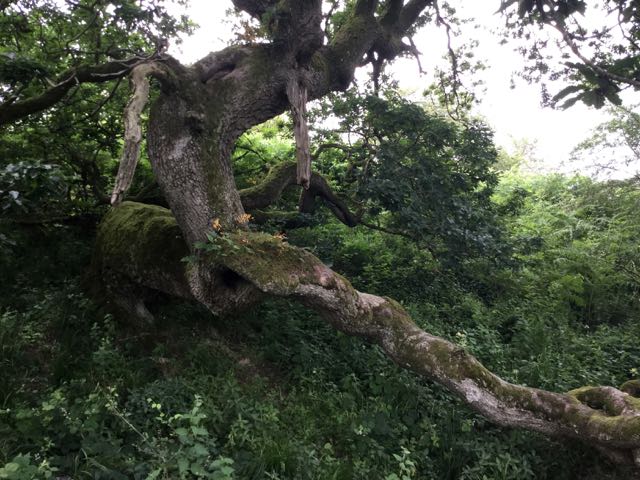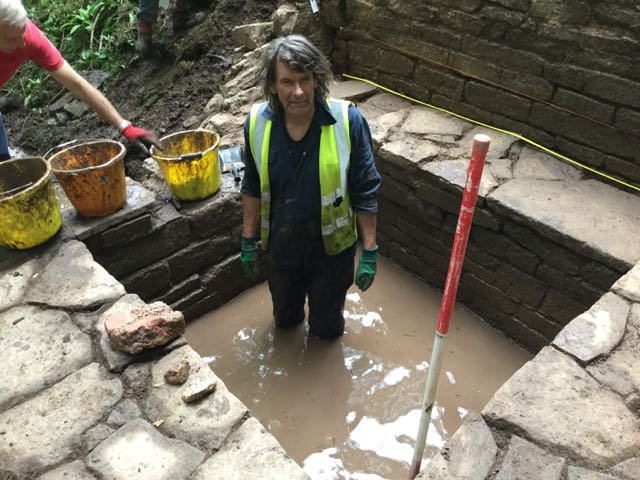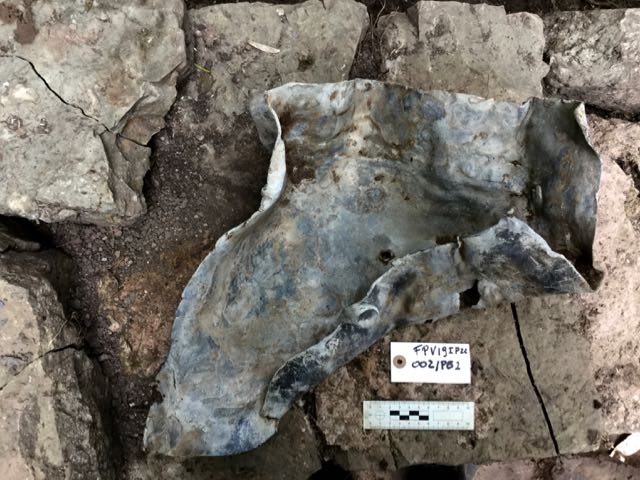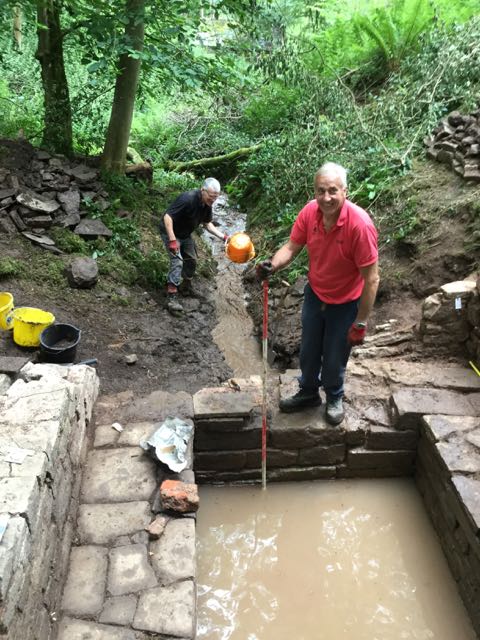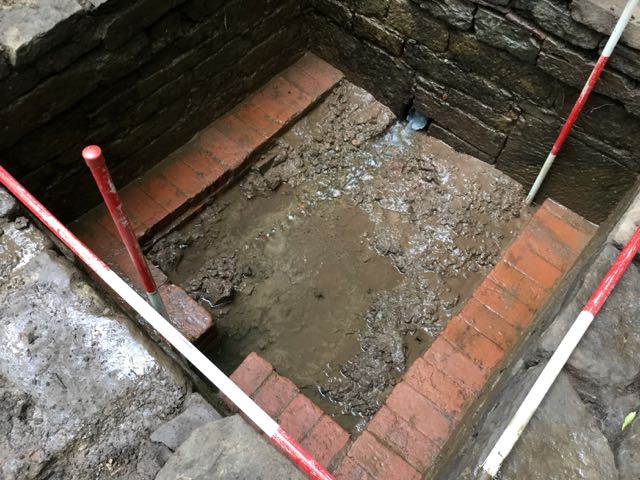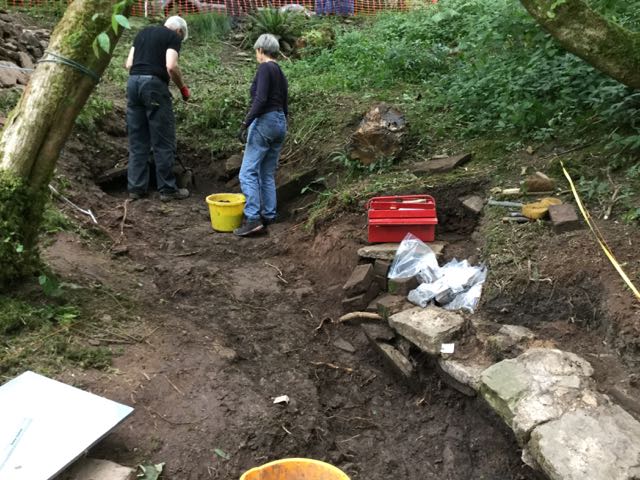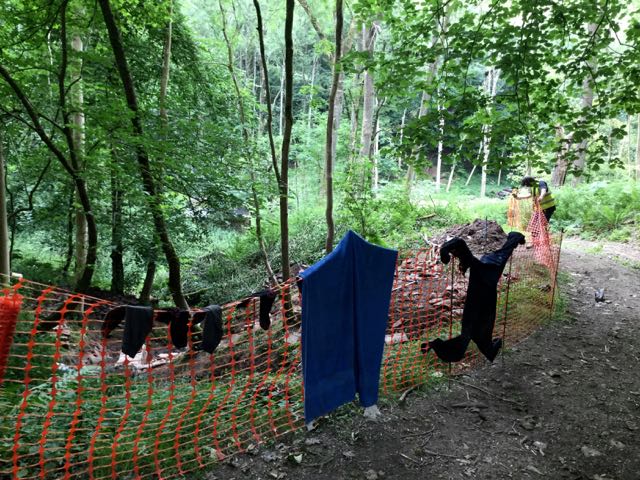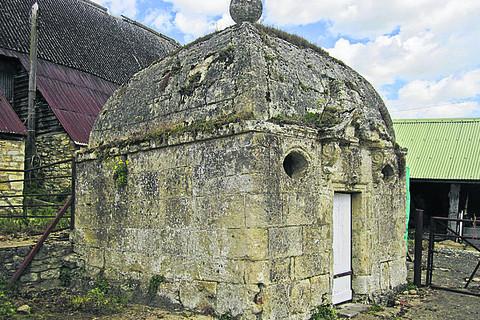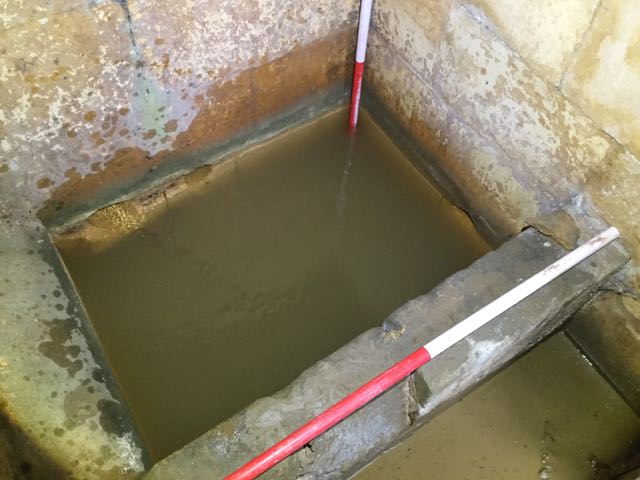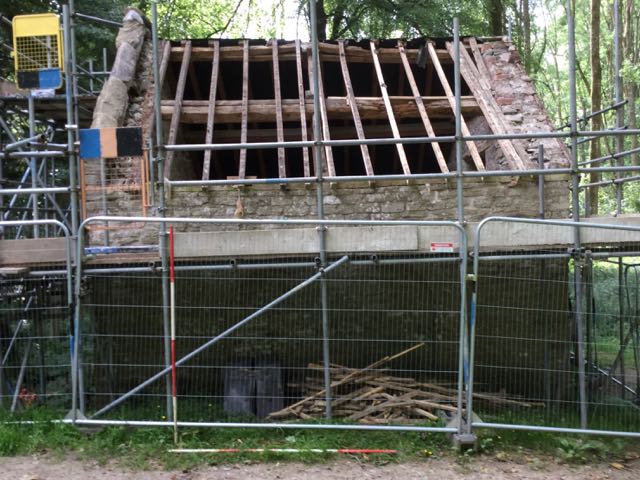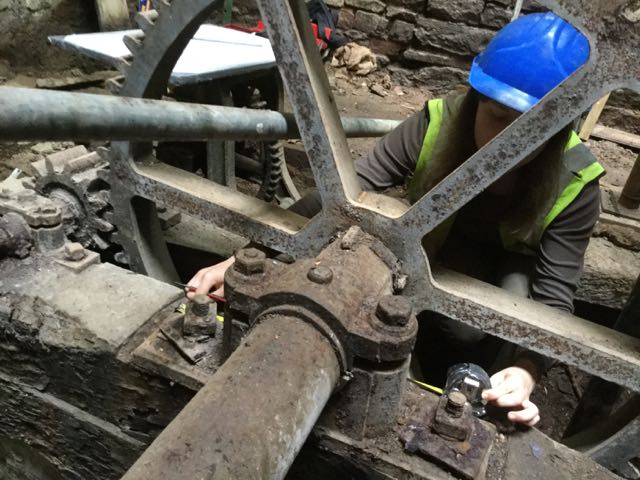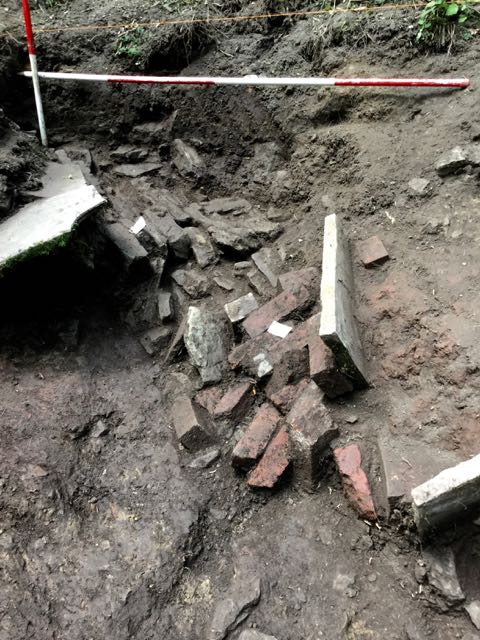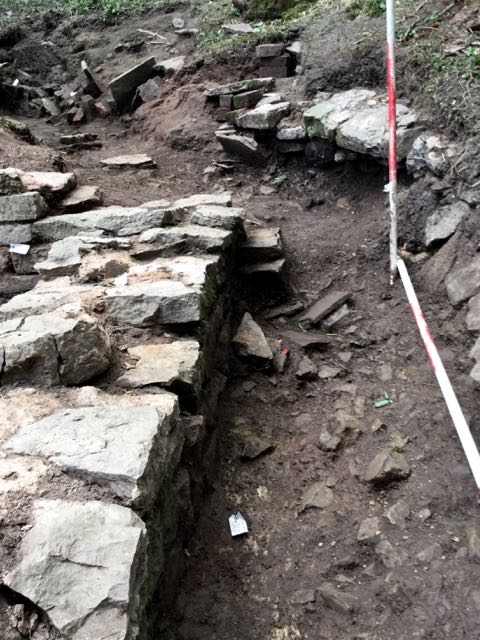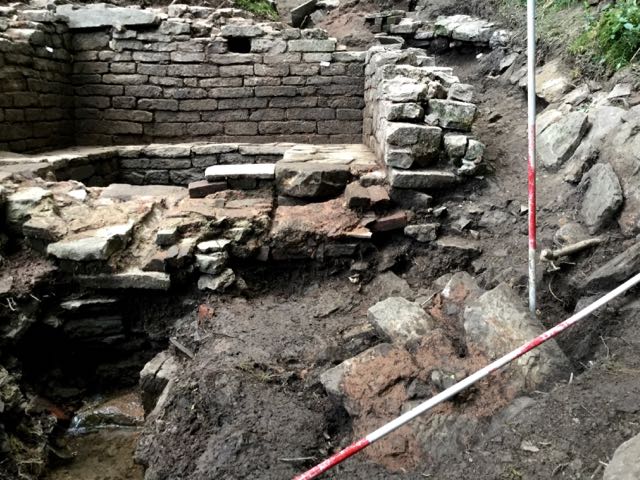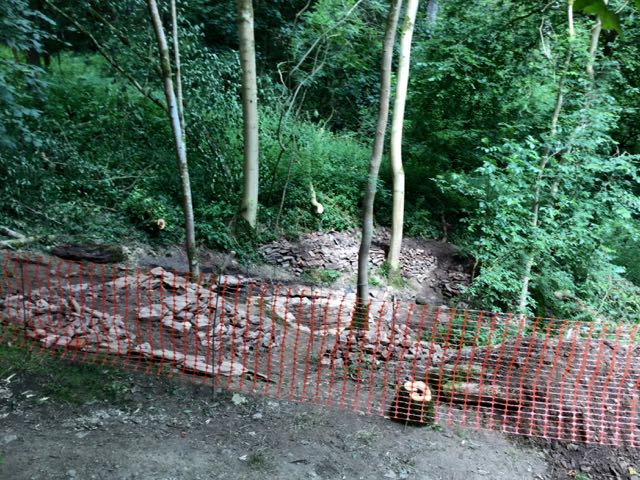T
he third season at Croft began in
May as the contractors undertook 'dry' work concentrating on the
restoration of the cascade on dam 7 and the spillway on dam 6. Work
anywhere near water was carefully avoided as it was breeding season
for the rare white clawed crayfish. This is what happened:
DAY 1
An interesting start to the week. I hadn’t appreciated the issues
around the crayfish at this time of year so we had to change our
plans a little. We opened up a trench just past the end of the
cascade to uncover a deep channel full of tumbled but well shaped
stones. Birch Brothers took out the stone sets from the cascade to
reveal a serious retaining wall and what may be the remains of an
earlier phase of spillway. All photographed and recorded. We also
opened an area above the west end of the dam to look for the other
end of the scouring tunnel examined in 2017. I’ve got an idea that
we are looking at a two phase structure here. The area marked on the
eighteenth-century estate map as a conduit is currently buried below
a mass of brushwood however we have permission to shift it and
Charlie was happy that it would be a crayfish free zone so we can
start on that tomorrow as well.
DAY 2
Another productive day. After I had drawn the new elevations of the
side walls to the cascade the contractors lifted one of the
capstones to examine the void below the main channel. This enabled
us to extend the elevations and take a look at the other side of the
cross wall. At the foot of the cascade a lot of topsoil and loose
rubble was removed from the channel. It was agreed that the tree
should go.
The test pit above the tunnel at the west end of the dam was cut
down at one corner by well over a metre to reveal what is assumed to
be the upper surface of the tunnel arch This area was fenced off due
to the depth of the trench.
The highlight of the day was a visit from Imogen bearing cake!
DAY 3
An action packed day with a sudden shift down to dam 6 to clean and
record the spillway. Jeremy Milln had drawn a part of the east wall
but the brick paving had not been seen so we opened it all out and
did some further excavation on the side walls facing the pool. At
this point it became clear that as well as a major slump close to
the centre of the spillway other areas of brick had also been
displaced and loosened from the underlying clay some of them were
bedded in. The surfaces were drawn at a scale of 1:10 and multiple
photos taken.
Back up at dam 7 two of the volunteers carried on looking for the
base of the cascade whilst the third ( thanks Malcolm) took down the
levels in the test pit above the conduit. Excavations here at the
start of the day uncovered a curious revetment of what appears to be
corrugated iron sheeting. More to investigate here tomorrow.
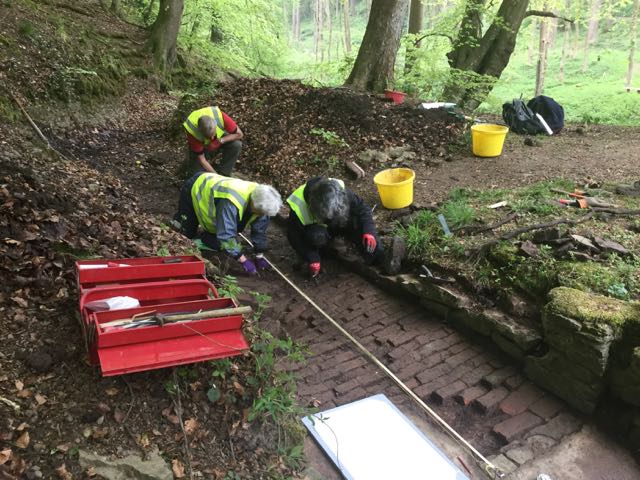
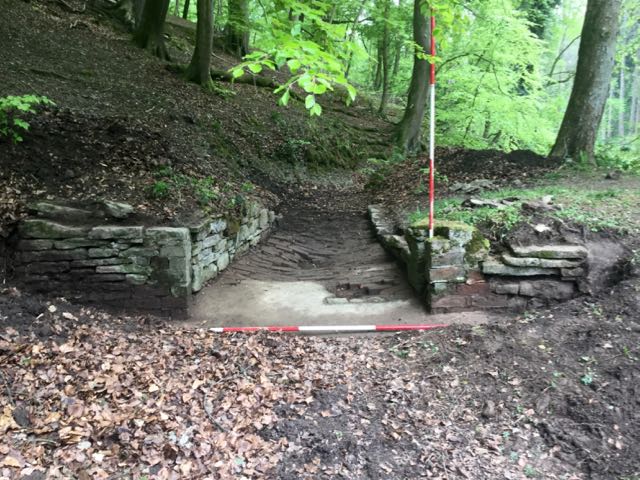
Relocated to the spillway on dam 6, a rush job to clean it all up
and record it in its pristine condition... if you ignore the slumps.

There are always lots of other things being done by the contractors
in the valley, here is work underway to improve access to dam 7.
DAY 4
Huge excitement up behind the modern pump house. The team of
volunteers started clearing the brush wood and followed the trail of
building debris until they stumbled upon a wall and not just any
wall but a well mortared one of large well dressed blocks. Exploring
further we ended up with a corner and a second wall and perhaps most
remarkable of all the remains of a ceramic tile floor! My best guess
at present is that the name 'The Conduit' on the late eighteenth
century estate map refers to a building centred on a natural spring
with stone walls, a tiled roof and probably home to a cold bath as
found at a number of other properties of the period. This could give
us the major focus for our investigations in July and potentially
another monument for valley bearing in mind that in places the wall
could survive to a height of 1.5m. The plan for tomorrow morning is
to uncover enough to identify the limits of the structure so I can
start to think about the logistics of any future full excavation of
the site plus there is a fallen tree to remove.
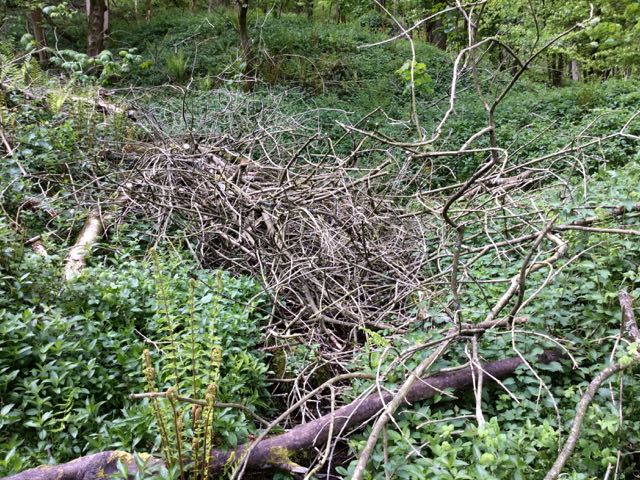
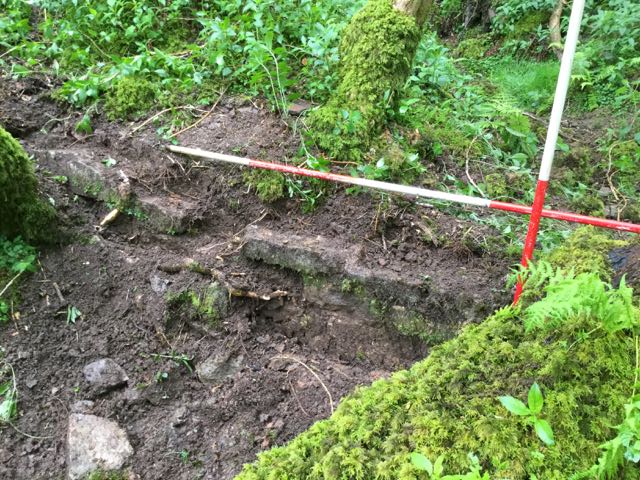
The impenetrable tangle of brushwood cleared by the volunteers... as
if by magic, OK actually with a lot of hard work, ultimately to
reveal.... a wall!
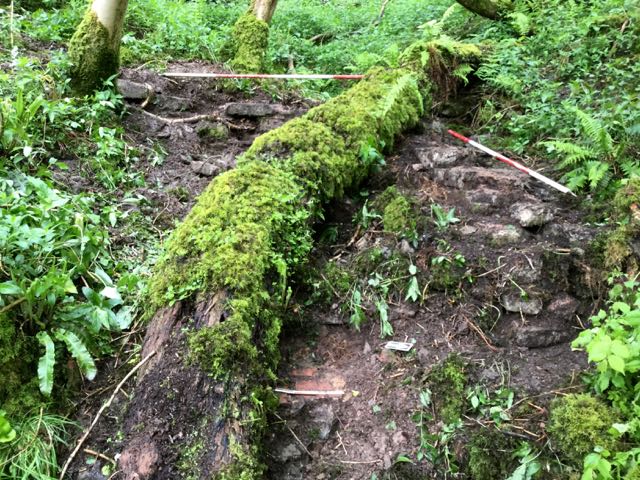
By the end of the day two walls and a corner.
The tree at the foot of the cascade was expertly felled by Jason who
dropped it with great precision exactly where he wanted it and the
root was removed by Grant at the controls of the digger. Not much
new archaeology though we did get a chance to take a look at the
section through one of the side walls. I told Nick that I was
finished with the cascade so he was free to move on to the
construction phase.
Down at the spillway at dam 6 I excavated the area around the slump
at the centre of the brick paving and recorded the deposit beneath.
Again I handed this over to contractors who lifted and stacked the
remaining bricks.
The very deep test pit has now uncovered substantial walling, it may
be associated with the culvert but it stops way short of the
upstream face of the dam. Sections drawn and plan nearly complete,
tomorrow I’ll finish off and hopefully start back filling.
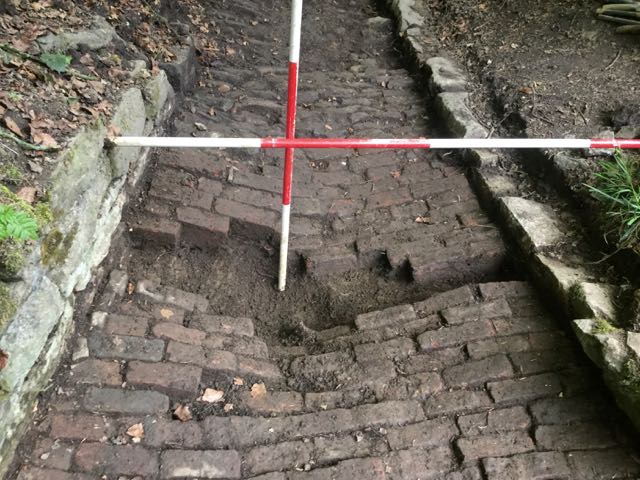
Exploring below the brick paving on the spillway to dam 6... it's
just dirt.

The tree is down, Jason slices it into manageable chunks ...
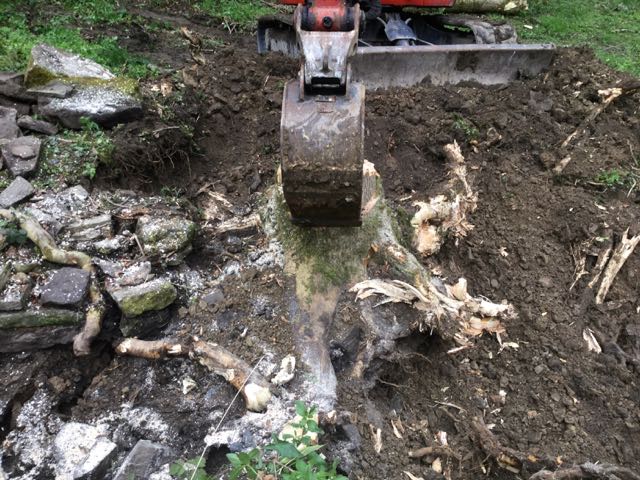
... and Grant digs out the stump ...
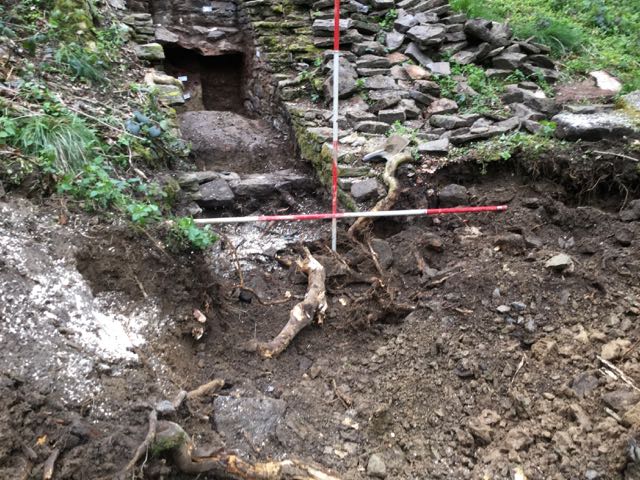
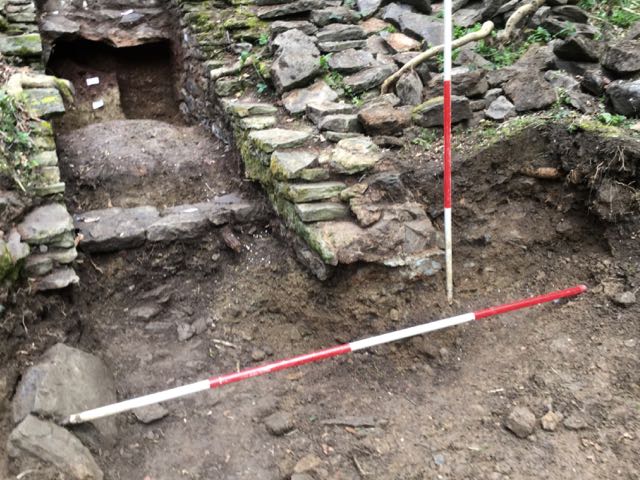
... leaving a mess which we tidy up to reveal, well not a lot
really.

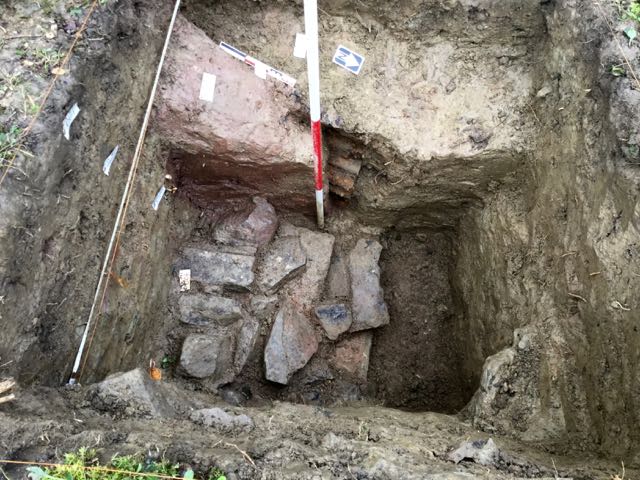
Back in the test pit the limit of what is safe to dig is reached,
it's time to try and understand it all.
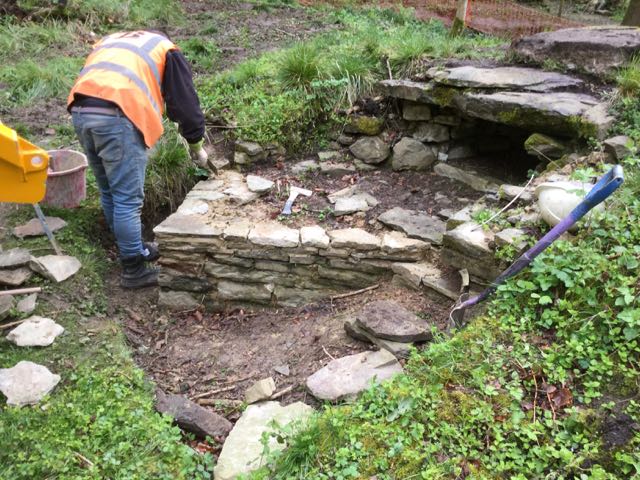
After all the dismantling it's great to see things being put back
together again, the foundation for the debris catcher at the top of
the cascade.
Well we certainly finished the week in style. Whilst waiting for the
volunteers to arrive I completed the recording on our rather deep
test pit at the west end of dam 7. We ended up with quite a
complicated sequence involving the culvert through the smaller
earlier dam of red clay being sealed by a cross wall before the
later larger dam was dumped on top.
From 10.00 onwards the team of 5 volunteers set to to meet my
immediate objectives namely first off to remove enough vegetation
and topsoil to enable everyone to see the character of the new
monument we have added to the Croft landscape and also explore
the limits of the site to aid me in thinking through logistics for
July on the grounds that we may want to proceed with further
investigations into this structure. With extraordinary efficiency a
member of the Trust's staff turned up with his chain saw and we were
able to slice up and remove the trunk of a fallen tree that was
hampering our efforts. This enabled us to see the big picture of an
extremely well build stone structure - probably square and
note arrangements for flooring (at least two periods) and draining
the structure. At the moment I'm going to stick with the idea that
this was both a conduit house which tapped the natural spring but
could have been a cold bath too.
Huge thanks to all the volunteers and especially the team who went
back in the rain on Friday afternoon to fill in the big test pit.
There's so much to look forward to later in the summer.
I was back for just one day later in May to take a look at the floor
in the pump house. Scaffolding had gone up around the structure but
I was mainly concerned with what was going on inside. With marvelous
assistance from the contractor we were able to shift at least a
tonne of assorted debris, all of it in buckets and up a ladder,
before I cleaned by hand and then recorded a variety of different
flooring 'episodes'. Once this was done the additional props and
scaffolding needed for the next stage of the work could go in.
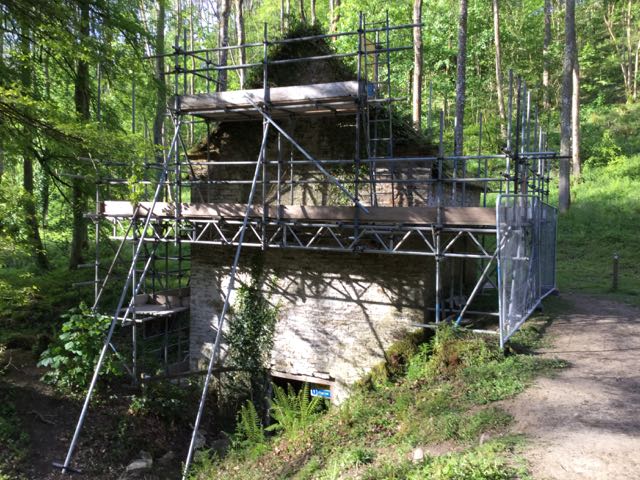
The pump house from the north encased in scaffolding/
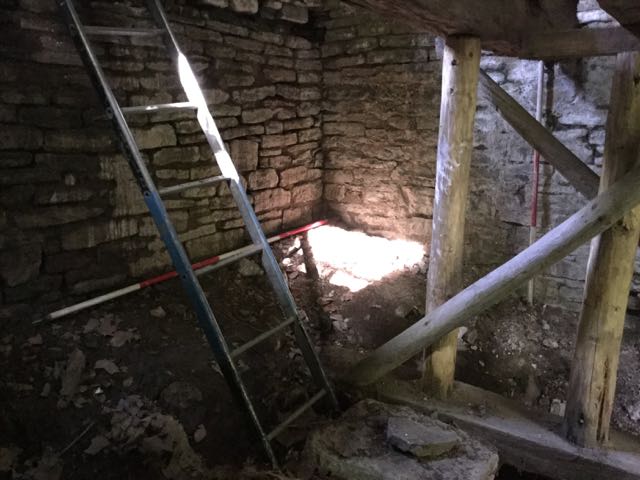
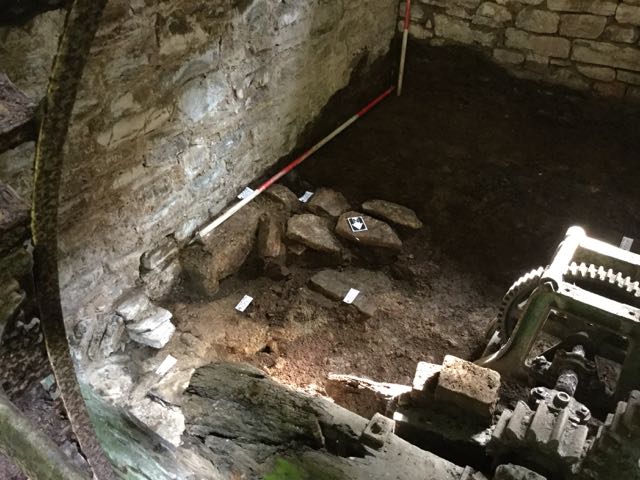
the interior, a nightmare to photograph on account of the uneven
light and shade but with a variety of flooring materials and
surfaces
And so onto July.
As planned week one began on the site of the Conduit here
are the daily reports:
DAY 1
Arriving around midday we were able to join some of the volunteers
for lunch before heading down to the valley. Birch Brothers were
there waiting for their welfare facilities to be delivered. Our team
of volunteers made an excellent start clearing the undergrowth and
beginning to remove turf and top soil and large amounts of rubble
especially from the south wall of the building. Early days yet so
several options remain open regarding the nature of the structure.
The big issue will be the continuing question of what to do with the
spoil, lots of carrying material up the slope to dump it. Anyway we
have the area cleared and marked out and are set to press on
tomorrow. There is an issue, we really need to remove a small ash
tree growing in the south west corner, perhaps we can get Jason to
look at it.
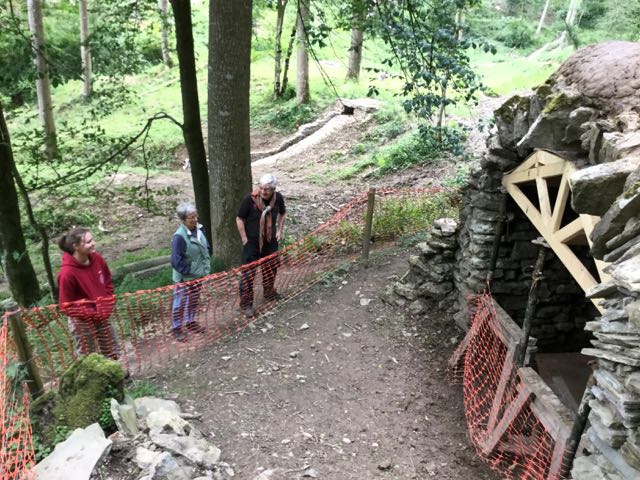
Before we started we visited some old haunts to examine the work
being done on the grotto and the finished work on the cascade.
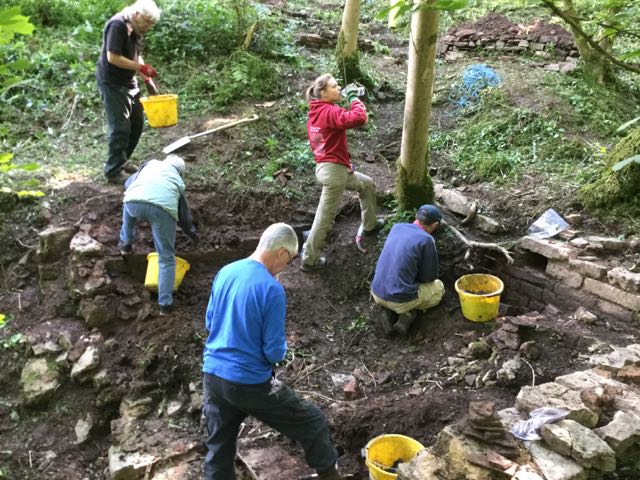
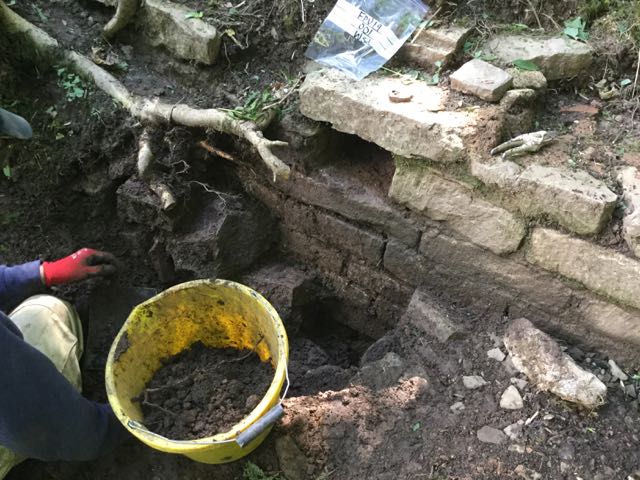
Everyone sets to work with a will on a preliminary clearance of the
site. On the west side tree roots are exposed plus an opening which
may have brought in the original piped supply of spring water to the
pool.
DAY 2
Sarah and I started the day up at the summer house where we weeded
and swept, tidying up the monument before roping it off. Back at the
Conduit work was facilitated no end by Jason popping up to fell a
small sickly ash tree and then by David slicing it up and Malcolm
helping clear the timber. Sarah and Viviana then excavated what
looks like a later drain and perimeter wall whilst levels within the
walled area were progressively reduced as buckets of soil and rubble
were hauled away. Midway through the afternoon Ian uncovered the
edge of a deep central pool surrounded by a paved walkway about 65cm
wide. A little later excavations within the south east corner
revealed the remains of what looked like slate paving, all
enormously interesting. Results tomorrow should be really
spectacular.
I also monitored the work done down at dam 7 where the concrete
barrier was broken out. At the end of the day I recorded a rather
uninteresting profile through the dam.
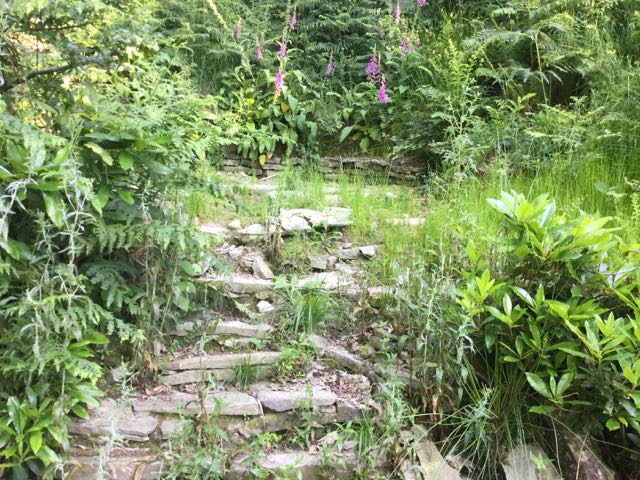

The steps and summer house site slightly overgrown and half an hour
later tidied up.
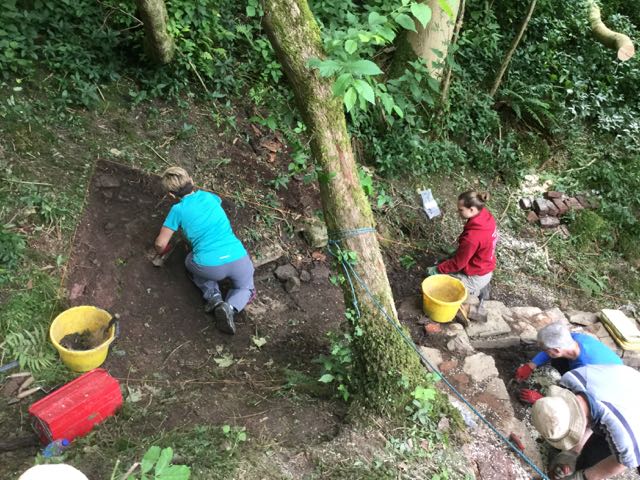
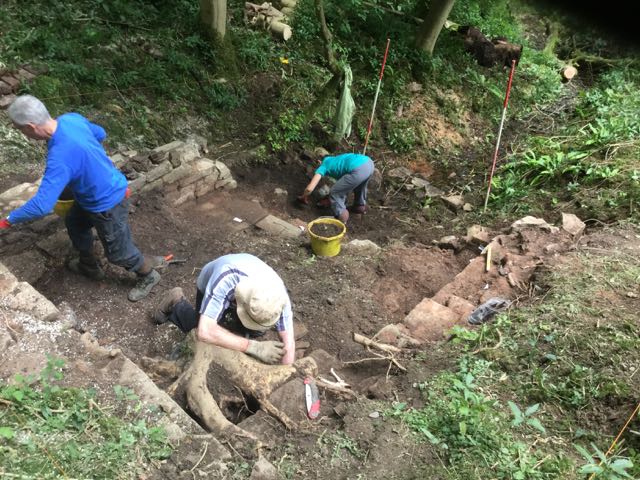
Viviana investigates a curious arrangement of bricks and stone
'upstream which turns out to be a drain whilst below, with tree cut
down the roots a teased out from the wall.
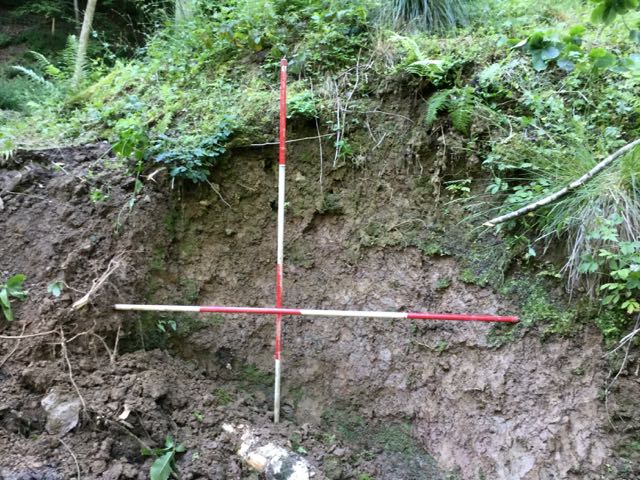
A partial section through dam 7 not especially informative as we are
well above the level of the stonework to the east.
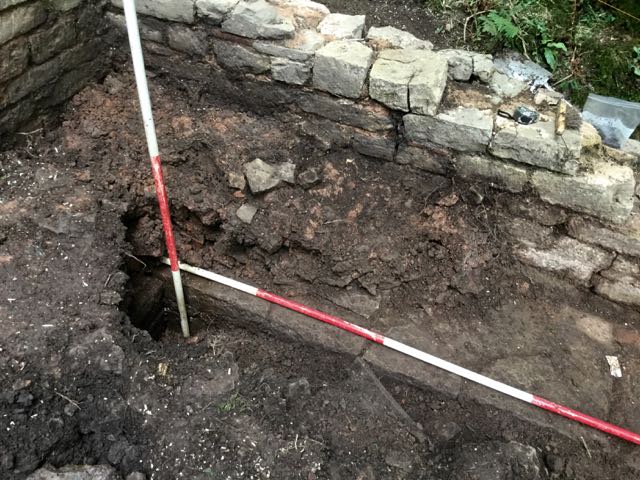
Thanks to Ian's efforts the extent of the walkway and the edge of
the central pool start to become clear.
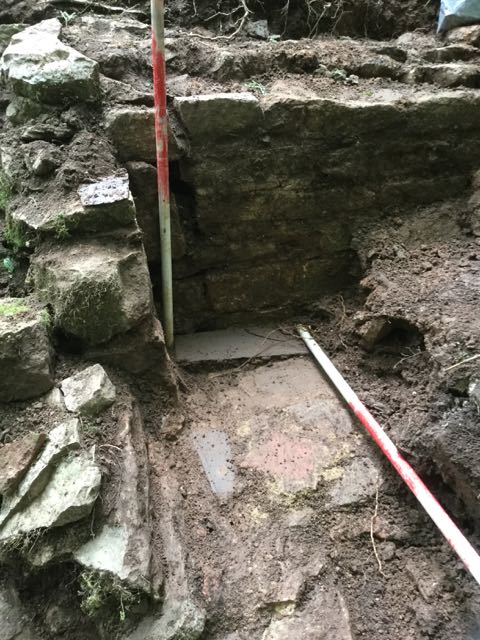
Whilst in the south east corner for a moment I think we have slate
paving... we haven't.
DAY 3
A terrific effort from all concerned today. The morning was devoted
to excavating the top of the south wall but then after that it was
all hands to the inside and the shifting of huge quantities of brick
and rubble. We set up a really efficient system for filling buckets
and removing spoil. As a result we now have exposed around two
thirds of the peripheral walkway and about half the perimeter of the
central pool. Tomorrow we shall hopefully complete the uncovering of
the full extent of the pool which is looking pretty square. The
surrounding wall is now standing to a height of 1.2m in places.
DAY 4
Down to the pump house first thing to take a closer look at the
current state of the inside. The scaffolding will certainly help
with access for some of the drawings although it is rather in the
way when it comes to making a photographic record. Essentially this
means we'll be quite happy to get on with the work next week without
any further input from the contractors.
Recording was started in earnest on the Conduit or plunge bath as we
should perhaps now call it. The site plan is well underway and
profiles and elevations completed. There’s still plenty of drawing
to do but we aim to have the bulk of it done by lunchtime tomorrow
when we depart for the weekend. Our heroic crew of volunteers: Fran,
David and John really worked hard on the rather thankless task of
clearing an increasingly sticky mass of fallen brick and rubble to
the point where we now have the entire perimeter wall and walkway
uncovered and have started to excavate the pool itself. I’m hoping
to at least see the bottom tomorrow which I guess will give us a
pool somewhere between 1 and 1.5m deep.
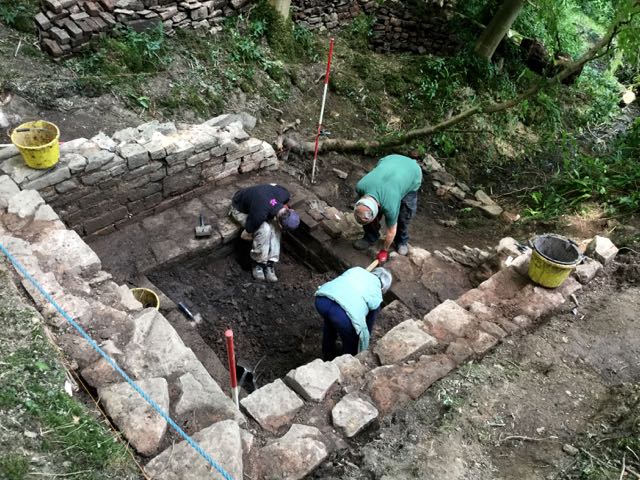
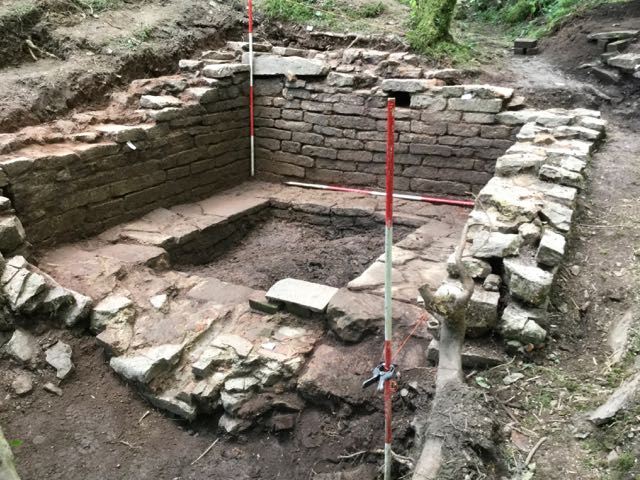
By lunchtime we had the sides all clear and were able to concentrate
on the central pool and here is the site at the end of the day. Note
the overflow channel in the middle of the east side.
DAY 5
So we did not get down to bottom this morning despite everyone's
best efforts, still it leaves us well poised for next week. A
few things remain concerning about the site. Firstly apart from the
tile and brick along the east side in what quite frankly looks like
a bit of a repair job, we have no evidence to date the structure.
Take that away and you could be looking at a well preserved Roman
monument! Then there is the question of its function. Cold bath /
plunge pool remains the favourite although there is the issue of the
naming of the site as 'conduit'. If this was simply an elaborate
arrangement to collect spring water the question is what was then
done with it? Should we be concerned that the tank does not have a
waterproof lining?
Next week will certainly see the excavation of the tank completed
and although finds have not been particularly common there are
certainly exciting possibilities as we reach the bottom. We will
then see what mechanism existed for draining the pool nd hopefully
we will be able to dig outside the east wall and uncover the
outlet channel. there will be more work to do up stream to examine
the water supply to the site plus the possibility exists that there
may be other structures in the vicinity which we will need to
identify.
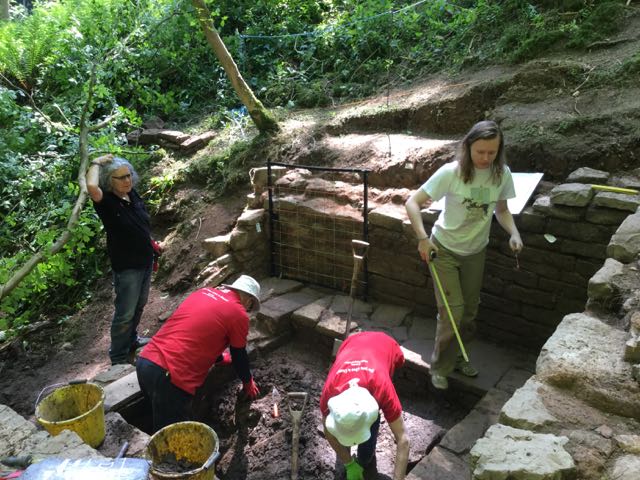
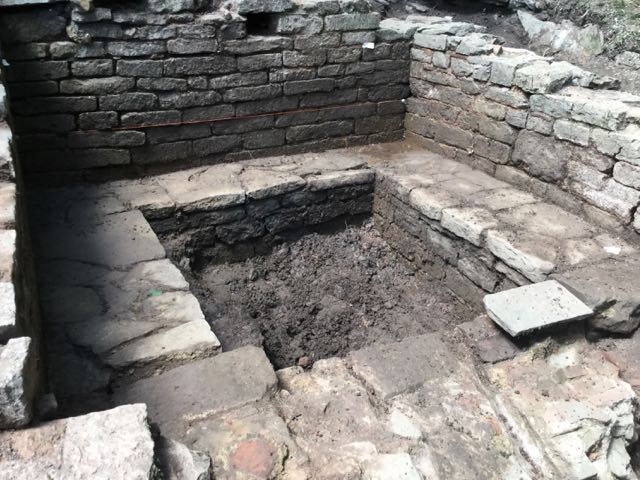
A busy scene as the pool is cleared with Clive and Joan hands on
with Julie working the bucket chain and the recording continues
apace and here is the pool with three or four courses of walling at
close of play on Friday.
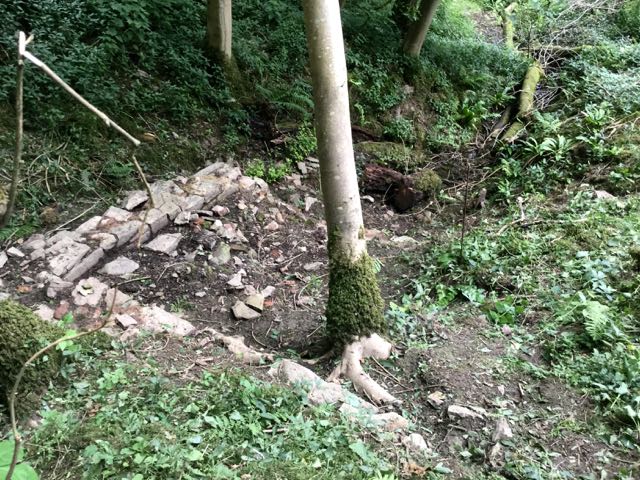

The classic before and after photos, the view looking north
east from the start of the week to the end.
DAY 6
Starting once more at lunchtime on Monday we continued recording
the stone walling with elevation drawings. The volunteers again
did sterling service: Ian, David, Clive and particularly Joan
worked with a will to lower the levels of rubble within the
central pool. This paid off as we uncovered an additional step
in brick round the north, east and west sides as well as the
site of the outflowing drain. Especially exciting was the
discovery at the foot of the west wall of the incoming supply in
a lead pipe still flowing with crystal clear spring water!
Beyond the pool, down stream, we removed quantities of rubble to
ensure a ready flow of water out of the site.
To the north of the main structure Sarah and I worked on the
incoming drain and the separate largely collapsed retaining wall
excavating a new stretch and drawing the western most part. Late
in the afternoon we undertook a quick inspection of the on-going
work on dam 7 photographing a newly exposed section on the north
side as well as examining other spring locations further up the
valley.
DAY 7
The first couple of hours were spent in surveying the fabric of
the pump house itself together with the wheel pit and the
timbers that carried the wheel and associated gearing. We met
with the contractor on site and agreed that our phase of the
recording work would be completed by the end of the week .
Back up at the conduit work continued to remove the rubble fill
from the central pool. From this point onwards excavation was
essentially carried out by touch under water. A particularly
significant find was a large piece of folded lead sheet that
looked as if it had been used to cap a post or possibly a
pyramidical roof. At one stage the outlet became blocked and the
pool rapidly refilled until Malcolm managed to clear it. The
gush of water downstream was quite impressive. Beyond the east
wall Ian, Julie and Malcolm deepened the channel but more
importantly began examining the outer face and foundation of the
east wall. Sarah who had spent the morning excavating the next
stretch of the northern retaining wall moved on to work on
elevations whilst I completed the plan of the walkway.
Meanwhile John and Fran had made a start on investigating the
area ‘up stream’ beyond the north west corner of the pool. A
series of features, largely in a state of collapse, were
identified including a couple of additional drains and a
possible pitched stone surface.
We were able to welcome several visitors to the site and those
who brought dough nuts were especially welcome. I had been in
correspondence with Julian Munby, head of buildings archaeology
at Oxford Archaeology and he was able to cite a number of
similar structures in and around Oxfordshire with a ledge around
the sides of the central pool which were without a doubt conduit
houses and this rather sways opinion away from a plunge pool
towards a structure connected with the water supply which is by
the way excellent, I sampled it this morning.
DAY 8
Back again for a couple of hours into the gloom of the pump
house to carry on with the intensive business of measuring and
drawing the surviving machinery and then after a quick burst of
work up at the Conduit alongside the volunteers we all had to
retreat to a safe distance whilst Louis, under Jason's
supervision, took down a Wych Elm that was growing almost
immediately above the west wall of the building, it had to go.
Once cleared, and further thanks to John for shifting all the
trimmed off branches, we could resume work. This resulted in the
second significant find of the excavation a splendidly
engineered combined filter and plug all made in lead. We were
carrying on working underwater and excavating pretty well blind
to remove fallen roof slates, stone and brick. Another stunning
effort, again, especially by Joan and Clive.
By the end of the day we had probably pulled out enough material
to bring us within striking distance of the bottom... or so we
thought. Efforts had continued apace, particularly on the part
of Ian to deepen the out-flowing channel to reduce water levels
in the tank. Unfortunately the deeper we dug the further down
stream the channel had to be cut. Finally after having made
several measurements we concluded that we just wouldn't be able
to to go any further with this particular epic struggle.
Meanwhile efforts were made to work up the small valley to the
north west in order to make sense of the jumble of stone and
brick up that end, no sense to it yet .
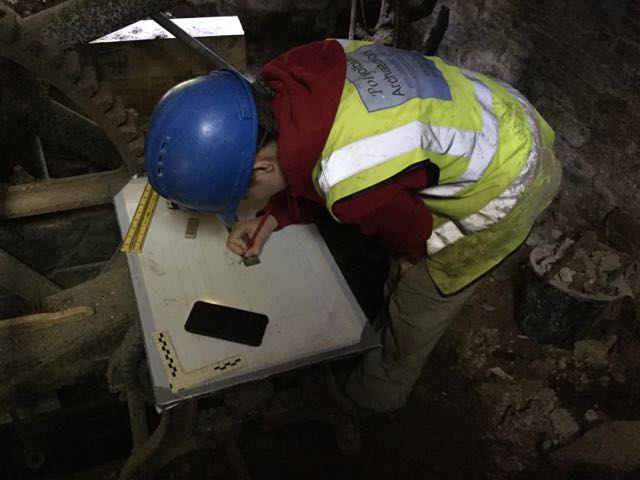
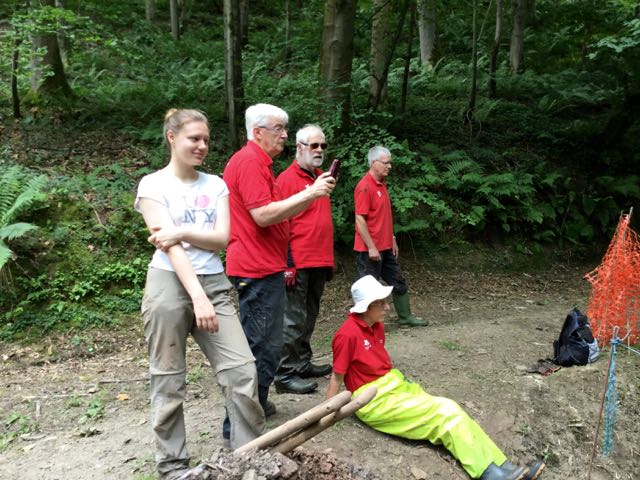
In the depths of the pump house, full PPE gear. A slightly more
casual look, apart from Joan's water proof trousers, as we watch
trees get cut down.
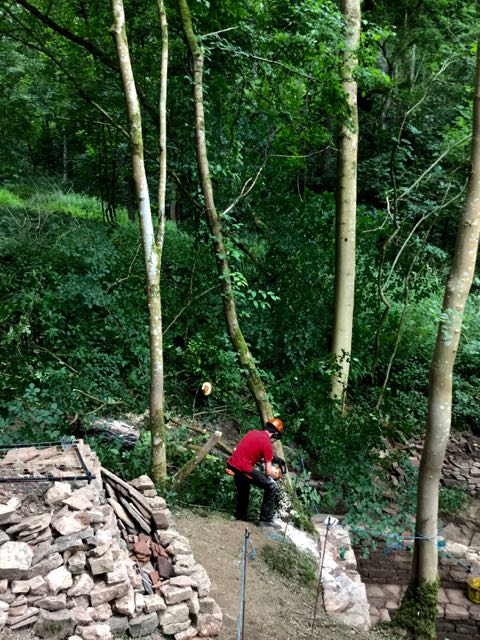
... and here it goes, Louis in action.

Back in the tank Joan is delighted as the lead filter comes out.

Intensive work at one point to lower levels by bucketing, it
worked up to a point but then re flooded.
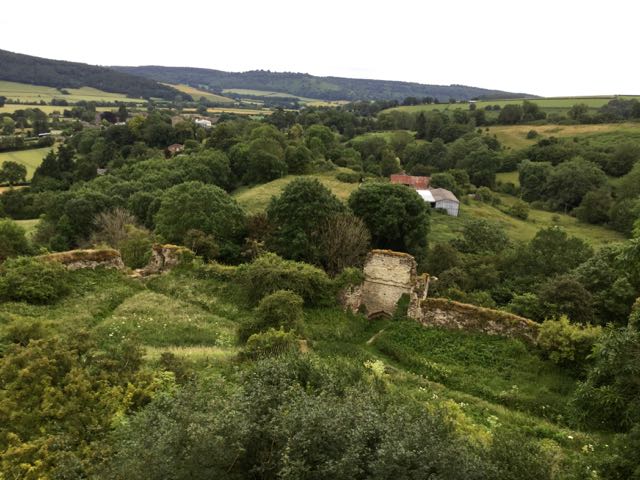
... and the fruits of another post-dig archaeological
excursion, the view from Wigmore Castle.
DAY 9
On the previous day the contractors had partly removed the
roof to the pump house letting in for the first time for some
time some much needed light. This speeded up our job no end and
we were pretty well able to complete the planning and
photography in the first couple of hours of the day. Back up at
the Conduit we were joined by Janine who was up for a serious
day of digging plus later in the day the arrival of Imogen with
a whole crowd of visitors around for a conference but down to
see the sights.
Work concentrated on the area to the north and west of the
building with a degree of clarity being achieved in the sense
that it was pretty obvious that we were looking at an area that
had been subject to repeated attempts at drainage followed by
occasional catastrophic episodes of flooding with the consequent
destruction. One very remarkable discovery involved the
excavation of few stones by Anita and Fran just down from the
north east corner of the building which turned into a complete
collapsed corner from the original structure. Down in the tank a
determined effort was made to reach the bottom. This involved
almost complete immersion in order to reach down deep enough to
lift out the accumulated rubble and mud. It became clear after a
little probing that we may have hit bottom by 'digging' in just
a small area in the south east corner but this was at a depth of
nearly 1.10m below current water levels. Reluctantly we decided
there was no future in pursuing this until we could reliably
drain the tank and keep it dry, perhaps a task for next year?

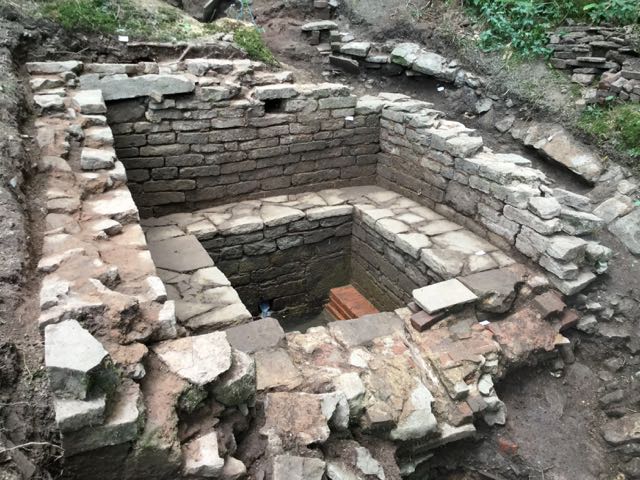
The ultimate before and after photo, May to July 2019
